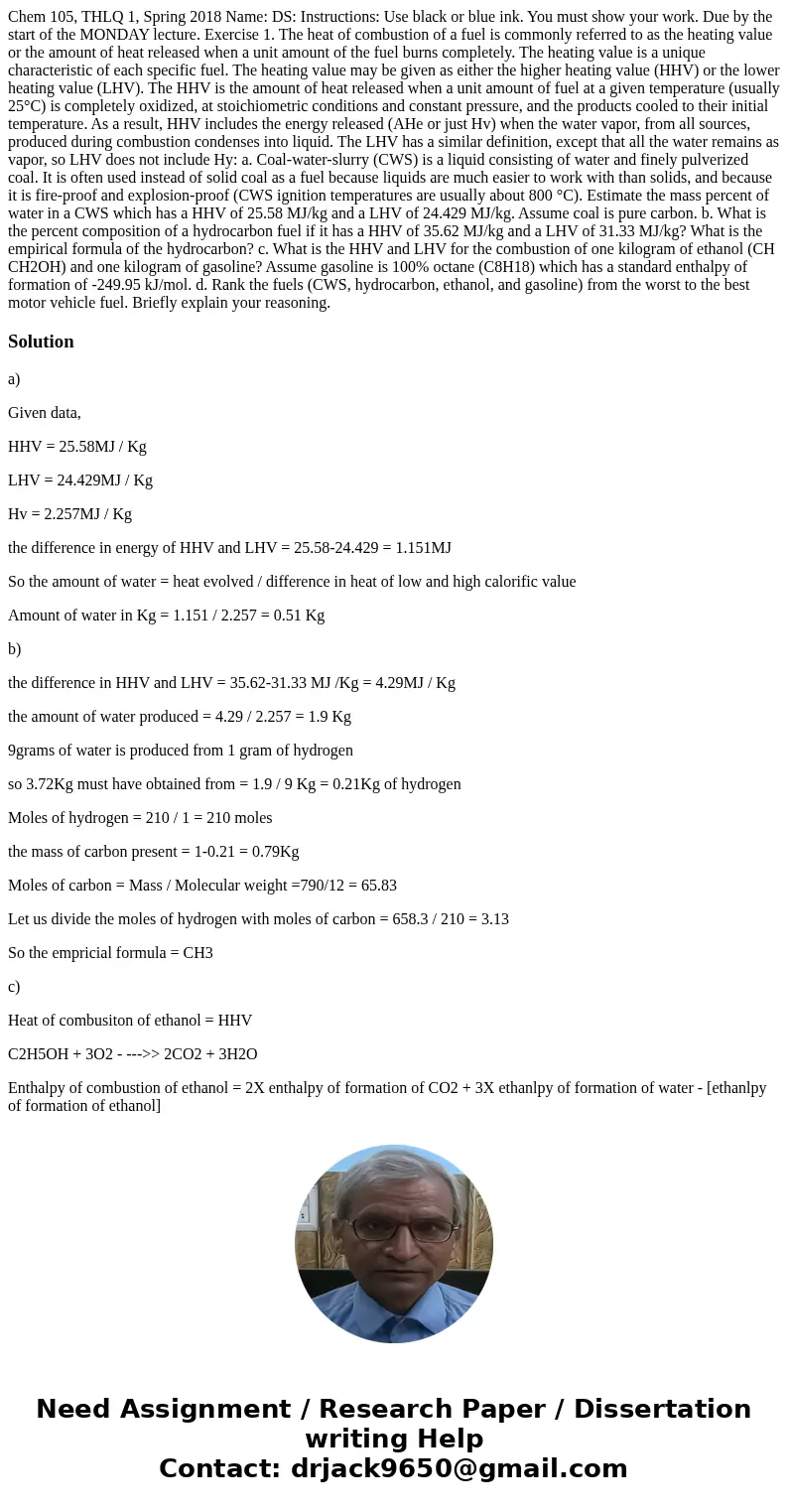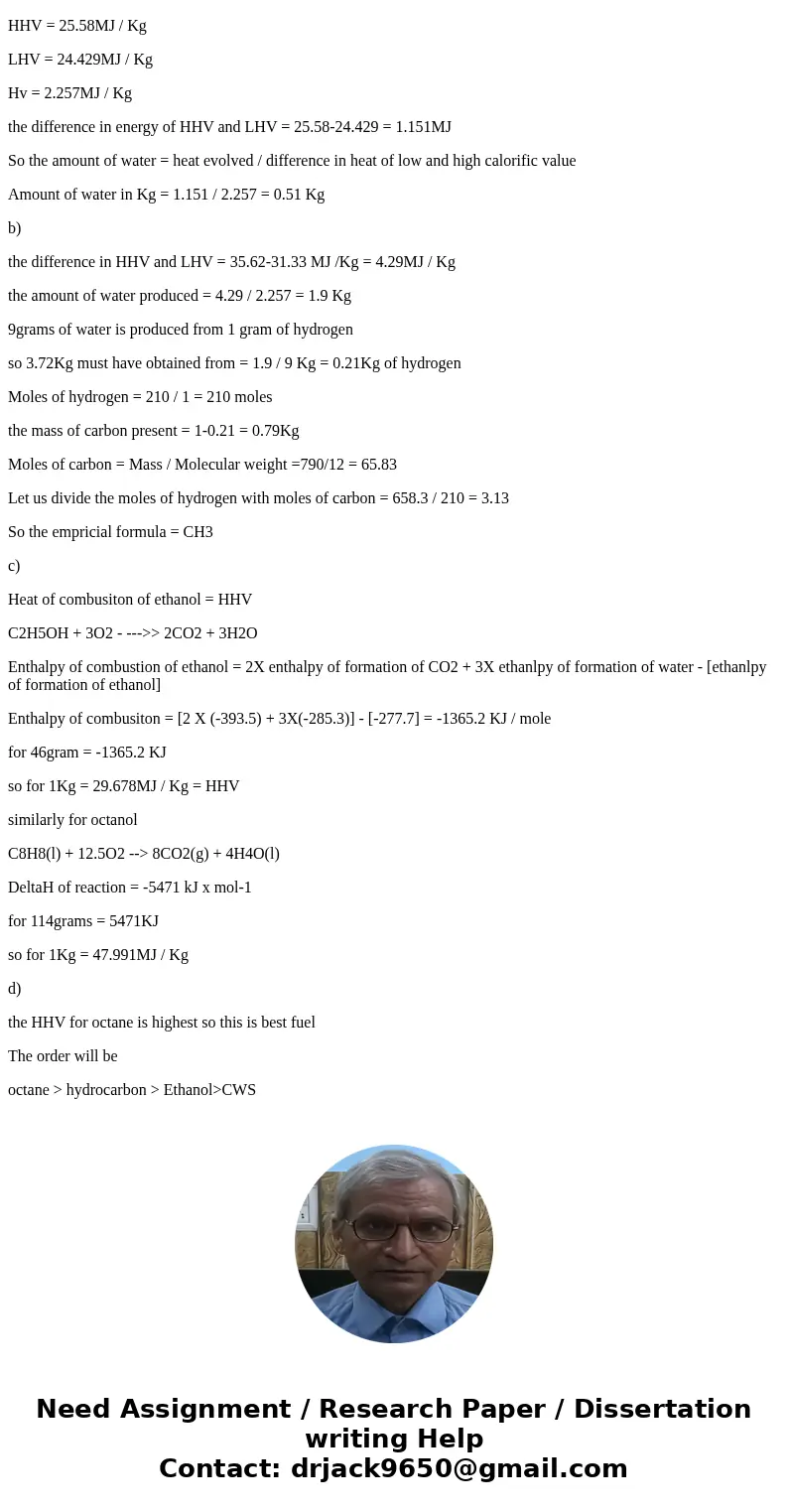Chem 105, THLQ 1, Spring 2018 Name: DS: Instructions: Use black or blue ink. You must show your work. Due by the start of the MONDAY lecture. Exercise 1. The heat of combustion of a fuel is commonly referred to as the heating value or the amount of heat released when a unit amount of the fuel burns completely. The heating value is a unique characteristic of each specific fuel. The heating value may be given as either the higher heating value (HHV) or the lower heating value (LHV). The HHV is the amount of heat released when a unit amount of fuel at a given temperature (usually 25°C) is completely oxidized, at stoichiometric conditions and constant pressure, and the products cooled to their initial temperature. As a result, HHV includes the energy released (AHe or just Hv) when the water vapor, from all sources, produced during combustion condenses into liquid. The LHV has a similar definition, except that all the water remains as vapor, so LHV does not include Hy: a. Coal-water-slurry (CWS) is a liquid consisting of water and finely pulverized coal. It is often used instead of solid coal as a fuel because liquids are much easier to work with than solids, and because it is fire-proof and explosion-proof (CWS ignition temperatures are usually about 800 °C). Estimate the mass percent of water in a CWS which has a HHV of 25.58 MJ/kg and a LHV of 24.429 MJ/kg. Assume coal is pure carbon. b. What is the percent composition of a hydrocarbon fuel if it has a HHV of 35.62 MJ/kg and a LHV of 31.33 MJ/kg? What is the empirical formula of the hydrocarbon? c. What is the HHV and LHV for the combustion of one kilogram of ethanol (CH CH2OH) and one kilogram of gasoline? Assume gasoline is 100% octane (C8H18) which has a standard enthalpy of formation of -249.95 kJ/mol. d. Rank the fuels (CWS, hydrocarbon, ethanol, and gasoline) from the worst to the best motor vehicle fuel. Briefly explain your reasoning.
a)
Given data,
HHV = 25.58MJ / Kg
LHV = 24.429MJ / Kg
Hv = 2.257MJ / Kg
the difference in energy of HHV and LHV = 25.58-24.429 = 1.151MJ
So the amount of water = heat evolved / difference in heat of low and high calorific value
Amount of water in Kg = 1.151 / 2.257 = 0.51 Kg
b)
the difference in HHV and LHV = 35.62-31.33 MJ /Kg = 4.29MJ / Kg
the amount of water produced = 4.29 / 2.257 = 1.9 Kg
9grams of water is produced from 1 gram of hydrogen
so 3.72Kg must have obtained from = 1.9 / 9 Kg = 0.21Kg of hydrogen
Moles of hydrogen = 210 / 1 = 210 moles
the mass of carbon present = 1-0.21 = 0.79Kg
Moles of carbon = Mass / Molecular weight =790/12 = 65.83
Let us divide the moles of hydrogen with moles of carbon = 658.3 / 210 = 3.13
So the empricial formula = CH3
c)
Heat of combusiton of ethanol = HHV
C2H5OH + 3O2 - --->> 2CO2 + 3H2O
Enthalpy of combustion of ethanol = 2X enthalpy of formation of CO2 + 3X ethanlpy of formation of water - [ethanlpy of formation of ethanol]
Enthalpy of combusiton = [2 X (-393.5) + 3X(-285.3)] - [-277.7] = -1365.2 KJ / mole
for 46gram = -1365.2 KJ
so for 1Kg = 29.678MJ / Kg = HHV
similarly for octanol
C8H8(l) + 12.5O2 --> 8CO2(g) + 4H4O(l)
DeltaH of reaction = -5471 kJ x mol-1
for 114grams = 5471KJ
so for 1Kg = 47.991MJ / Kg
d)
the HHV for octane is highest so this is best fuel
The order will be
octane > hydrocarbon > Ethanol>CWS


 Homework Sourse
Homework Sourse